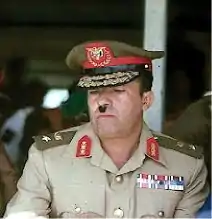Ahmad bin Hussein al-Ghashmi | |
|---|---|
 Ghashmi in 1976 | |
| 4th President of the Yemen Arab Republic | |
| In office 11 October 1977 – 24 June 1978 | |
| Prime Minister | Abdul Aziz Abdul Ghani |
| Preceded by | Ibrahim al-Hamdi |
| Succeeded by | Abdul Karim Abdullah al-Arashi |
| Personal details | |
| Born | 21 August 1935 Hamdan District, Sana'a Governorate, Yemen |
| Died | 24 June 1978 (aged 42) Sana'a, North Yemen |
| Manner of death | Assassination by explosion |
| Political party | None (Military) |
| Military service | |
| Allegiance | |
| Years of service | 1956–1978 |
| Rank | |
| Battles/wars | |
Ahmad bin Hussein al-Ghashmi (21 August 1935 – 24 June 1978)[1] (Arabic: أحمد حسين الغشمي, romanized: Aḥmad Ḥusayn al-Ghašmī) was the fourth President of the Yemen Arab Republic from 11 October 1977 until his death eight months later. Al-Ghashmi assumed power when his predecessor, Ibrahim al-Hamdi, was assassinated.[2]
Early life and career
Ahmad (Ahmed) al-Ghashmi was born in Hamdan District, Sanaa Governorate.[3] According to some sources he was born in 1938,[1] but according to others[3] he was born in 1941.
After the coup d'état of September 26, 1962, the North Yemen Civil War (1962-1970) began. Al-Gashmi took part in it on the side of Abdullah al-Sallal against Muhammad al-Badr.[3][1]
By the time Ibrahim al-Hamdi was president of Yemen, al-Gashmi was vice president of the Leadership Council and chief of staff.[3]
On 11 October 1977, al-Hamdi was assassinated and al-Gashmi took over the country.[1][2] A man believed to be a Saudi agent was accused of assassinating the president. Al-Gashmi himself was also suspected.[4][5][6]
Activities as President
President al-Ghashmi reinstated the 1970 Constitution, which had previously been suspended by al-Hamdi, the country's previous President, in 1974. However, an important body such as the Consultative Council was not reinstated, and at the same time the office of the President was introduced.[7]
He appointed Ali Abdullah Saleh as military governor in Taiz, who became the next president.[8]
Death
His assassination occurred on 24 June 1978 when he was meeting an envoy sent by People's Democratic Republic of Yemen President Salim Rubai Ali and a briefcase, reportedly containing a secret message, exploded, killing both al-Ghashmi and the envoy. It is not conclusively known who set off the explosion.[2][9]
Coincidentally, Rubai Ali died in a coup three days after this event.
See also
References
- 1 2 3 4 "Index Ge-Gj". Rulers.org. Retrieved 2014-08-26.
- 1 2 3 Varisco, Daniel Martin (16 August 2013). "At the end of Aden". Times Literary Supplement. NI Syndication Limited. pp. 16–17. Retrieved 12 November 2023.
- 1 2 3 4 "A History of Yemeni Presidents". National Yemen Newspaper. Retrieved 12 November 2023.
- ↑ Metcalfe, Beverley; Mimouni, Fouad (1 January 2011). Leadership Development in the Middle East. Edward Elgar Publishing. ISBN 978-0-85793-811-4. Retrieved 12 November 2023.
- ↑ Terrill, W. Andrew (2011). "The Conflicts in Yemen and U.s. National Security". Strategic Studies Institute, US Army War College. Retrieved 12 November 2023.
- ↑ Derhem, Waleed (11 June 2020). "The tribe during president Saleh: a friend or a foe". Theses and Dissertations. Retrieved 12 November 2023.
- ↑ Burrowes, Robert D. (1992). "The Yemen Arab Republic's Legacy and Yemeni Unification". Arab Studies Quarterly. pp. 41–68. Retrieved 12 November 2023.
- ↑ Aziz, Mr Sajid (28 July 2015). "Yemen Conundrum". CISS Insight Journal. pp. P65–78. Retrieved 12 November 2023.
- ↑ "President of Yemen Reported Murdered". The New York Times. Associated Press. 25 June 1978. Retrieved 12 November 2023.